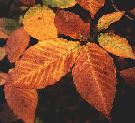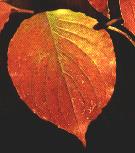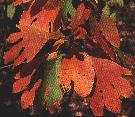
Beech

Dogwood

Sassafras

Poplar
- Leaves of some trees such as birches, tulip poplars, redbud and hickory,
are always yellow in the fall, never red.
- The fall leaves of a few trees, including sugar maple, dogwood, sweet gum,
black gum and sourwood, are usually red but may also be yellow.
- Unlike the bright colors of flowers, which attract pollinators, or the
bright "Warning Colors" of many kinds of animals, the bright colors
of fall foliage are a byproduct of chemical changes as the trees start to go
dormant. These colors have no apparent biological function or significance.
- The most intense of fall color occurs in in areas such as New England, with
almost pure stands of a few types of trees, such as maples and birches, that
all turn color at the same time during the short fall season.
- The most varied fall color, as well as the longest lasting, occurs in areas
such as the southern Appalachians, where a dozen or more kinds of trees may
change color at slightly different times over the longer fall season.
- The change in day length (photoperiod) that causes the chemical changes in
the trees leading to the bright colors starts June 21, the longest day of the
year, as the sun starts to move south and the days become shorter.
- Leaves have just as much yellow pigment (xanthophyll) in July when they are
green as they do in October when they are yellow. In July the darker green
pigment (chlorophyll) masks the yellow color.
- Evergreen trees may shed their older leaves, which often turn bright
yellow, in spring rather than fall, but they never drop all their leaves at one
time, thus staying green all year.
- The leathery evergreen leaves of rhododendron are shed individually from
time to time over several years; it is not uncommon to find individual
rhododendron leaves that have been on a plant for five or six years that are
still green, healthy and functional.
- Bright sunlight is essential for the production of the red (anthocyanin)
pigment in the fall leaves: if a black mask is placed on part of a leaf before
it turns red, the part of the leaf under the mask will turn yellow while the
exposed part will turn red.
From Fall Colors & Woodland Harvests
Laurel Hill
Press
PO Box 16516, Chapel Hill, NC 27516



